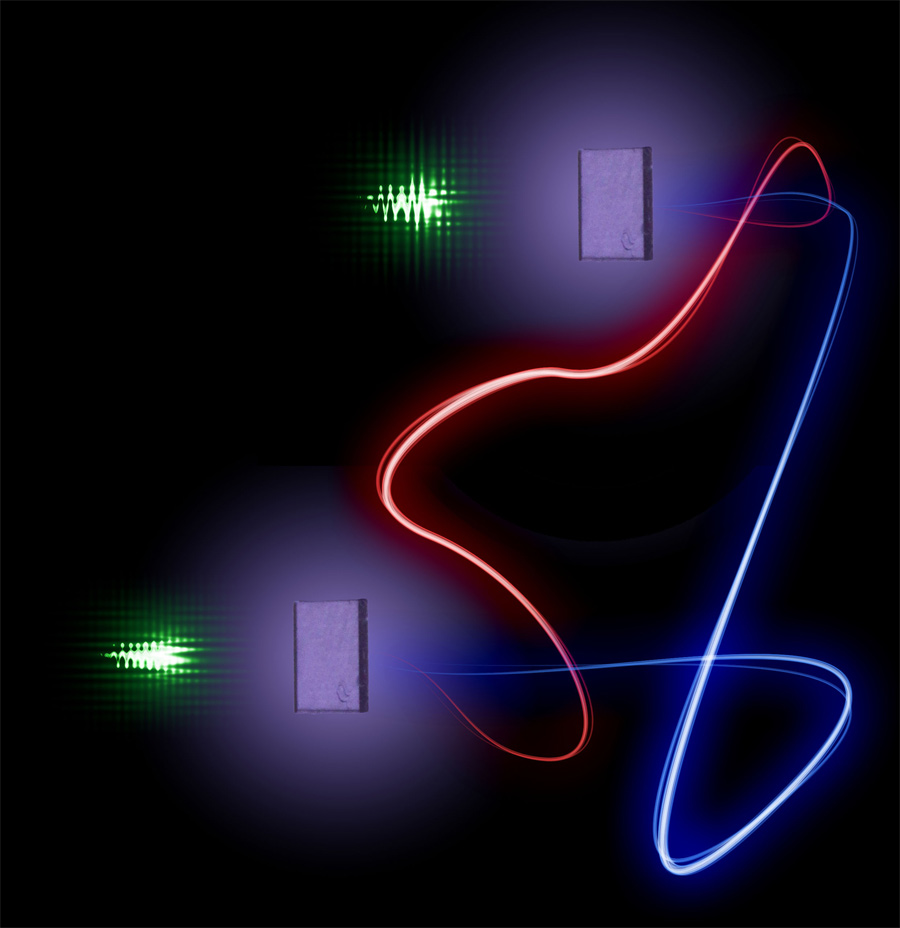Two Diamonds Linked by Strange Quantum Entanglement

Scientists have linked two diamonds in a mysterious process called entanglement that is normally only seen on the quantum scale.
Entanglement is so weird that Einstein dubbed it "spooky action at a distance." It's a strange effect where one object gets connected to another so that even if they are separated by large distances, an action performed on one will affect the other. Entanglement usually occurs with subatomic particles, and was predicted by the theory of quantum mechanics, which governs the realm of the very small.
But now physicists have succeeded in entangling two macroscopic diamonds, demonstrating that quantum mechanical effects are not limited to the microscopic scale.
"I think it's an important step into a new regime of thinking about quantum phenomena," physicist Ian Walmsley of England's University of Oxford said."That is, in this regime of the bigger world, room temperatures, ambient conditions. Although the phenomenon was expected to exist, actually being able to observe it in such a system we think is quite exciting." [Twisted Physics: 7 Mind-Blowing Findings]
Another study recently used quantum entanglement to teleport bits of light from one place to another. And other researchers have succeeded in entangling macroscopic objects before, but they have generally been under special circumstances, prepared in special ways, and cooled to cryogenic temperatures. In the new achievement, the diamonds were large and not prepared in any special way, the researchers said.
"It's big enough you can see it," Walmsley told LiveScience of the diamonds."They're sitting on the table, out in plain view. The laboratory isn't particularly cold or particularly hot, it's just your everyday room."
Walmsley, along with a team of physicists led by Oxford graduate student Ka Chung Lee, accomplished this feat by entangling the vibration of two diamond crystals. To do so, the researchers set up an apparatus to send a laser pulse at both diamonds simultaneously. Sometimes, the laser light changed color, to a lower frequency, after hitting the diamonds. That told the scientists it had lost a bit of energy.
Get the world’s most fascinating discoveries delivered straight to your inbox.
Because energy must be conserved in closed systems (where there's no input of outside energy), the researchers knew that the "lost" energy had been used in some way. In fact, the energy had been converted into vibrational motion for one of the diamonds (albeit motion that is too small to observe visually). However, the scientists had no way of knowing which diamond was vibrating.
Then, the researchers sent a second pulse of laser light through the now-vibrating system. This time, if the light emerged with a color of higher frequency, it meant it had gained the energy back by absorbing it from the diamond, stopping its vibration.
The scientists had set up two separate detectors to measure the laser light — one for each diamond.
If the two diamonds weren't entangled, the researchers would expect each detector to register a changed laser beam about 50 percent of the time. It's similar to tossing a coin, where random chance would lead to heads about half the time and tails the other half the time on average.
Instead, because the two diamonds were linked, they found that one detector measured the change every time, and the other detector never fired. The two diamonds, it seemed, were so connected they reacted as a single entity, rather than two individual objects.
The scientists report their results in the Dec. 2 issue of the journal Science.
"Recent advances in quantum control techniques have allowed entanglement to be observed for physical systems with increasing complexity and separation distance," University of Michigan physicist Luming Duan, who was not involved in the study, wrote in an accompanying essay in the same issue of Science."Lee et al. take an important step in this direction by demonstrating entanglement between oscillation patterns of atoms—phonon modes—of two diamond samples of millimeter size at room temperature, separated by a macroscopic distance of about 15 cm."
In addition to furthering scientists' understanding of entanglement, the research could help develop faster computers called photonic processors, relying on quantum effects, said Oxford physicist Michael Sprague, another team member on the project.
"The long-term goal is that if you can harness the power of quantum phenomena, you can potentially do things more efficiently than is currently possible," Sprague said.
You can follow LiveScience senior writer Clara Moskowitz on Twitter @ClaraMoskowitz. For more science news, follow LiveScience on twitter @livescience.



